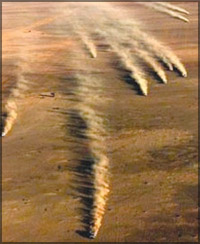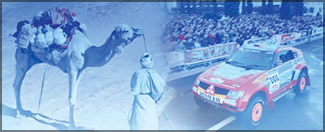
How the Dakar Rally started...
Over the years, you might have memorised that Dhaka is the capital
city of Bangladesh. The topic we are dealing with today with a similar
sounding name may imply that the rally has a connection to Dhaka.
 However, the truth is that the name of the rally comes from the city
'Dakar' of Senegal and this particular rally has been a primary racing
event of the world for the past twenty nine years. Although it was held
annually for the last twenty nine years, sadly this year's encounter
which was scheduled to be held in January was called off due to
terrorist activities in the region. However, let's look in to what this
contest is all about...... However, the truth is that the name of the rally comes from the city
'Dakar' of Senegal and this particular rally has been a primary racing
event of the world for the past twenty nine years. Although it was held
annually for the last twenty nine years, sadly this year's encounter
which was scheduled to be held in January was called off due to
terrorist activities in the region. However, let's look in to what this
contest is all about......
Although this event is famous as the Dakar Rally, it has been also
known as 'The Paris Dakar' or 'Paris to Dakar Rally'. But now the name,
'The Lisboa Dakar' is slowly becoming popular. This is an annual
off-road race, and the 'Amaury Sport Organisation' is the governing body
for this massive event.
As the name of the event implies that it is a rally, first we'll
enlighten you as to what a rally race is as we once explained in one of
the previous editions of Sports Track. It is a race where the drivers
and the co-drivers gather at some point and then leave the place at
regular intervals to reach a particular point.
However, this particular event is somewhat different to a rally in
certain aspects. Actually, it is an off-road endurance race rather than
a conventional rally because the terrain which the competitors have to
conquer is much tougher and the vehicles used are true off-road vehicles
rather than the modified sedans used in usual rallies.
 The entire rally takes place as a series in stages and the distances
covered in each stage varies from a few kilometres up to 800 or 900
kilometres per day. The entire rally takes place as a series in stages and the distances
covered in each stage varies from a few kilometres up to 800 or 900
kilometres per day.
All stages provide a truly challenging experience for the racers,
which are made up of land-forms like off-road sections, sand dunes, mud,
camel grass and rocks.
***
How the event evolved
Like many other sports, this event too has quite an interesting
beginning, which can be known as rather unusual. Way back in 1977, a
French racer named Thierry Sabine had got lost in the desert.
His first intentions might have obviously been to get out of the
hostile environment, however, later on, he had come up with the idea
that such desert terrain would be a good location for a race.
Ultimately, his dream became true and the first event was held in 1978,
one year after his adventure at the desert.
Originally, the rally had been held from Paris to Dakar. However this
wasn't a continuous race since there was an interruption in the race
course due to a transfer across the Mediterranean Sea.
 Over time, the course, including origin and destination, had
undergone change due to politics and other factors. Dakar has been the
destination city during all races except four. Over time, the course, including origin and destination, had
undergone change due to politics and other factors. Dakar has been the
destination city during all races except four.
Paris has been the starting point for the race until 1995. The race
in 1994 was special since it was scheduled that the starting point as
well as the ending point should be Paris.
But, due to complaints by the mayor, the finish had to be moved from
the Champs -?lys,es of Paris to Euro Disney. As a result of this, the
locations were changed in successive encounters of the event.
***
Classes of vehicles
The Dakar Rally is a race which tests the endurance of the driver as
well as the machine which he is driving. Therefore, the vehicles which
are used in the race are extremely rugged and powerful. These machines
are divided into three categories; Moto Class, Car Class and Truck
Class.
The Moto Class consists of bikes which are once again divided in to
three sub categories ranging from group one to three. Group one bikes
are merely unmodified bikes and once you go up to group three the
modifications and engine capacities of bikes increase.
 The Car Class is a collection of many vehicles like buggies and
Sports Utility Vehicles (SUVs). However, the demarcation is done by the
weight of the vehicles, which specifies that vehicles coming under this
category should be below 3,500 kilograms. The Car Class is a collection of many vehicles like buggies and
Sports Utility Vehicles (SUVs). However, the demarcation is done by the
weight of the vehicles, which specifies that vehicles coming under this
category should be below 3,500 kilograms.
Car production companies make it a point to come up with a vehicle
with the best performance since a top rank in this race truly becomes an
amazing marketing vehicle. At present the main competitors in the car
class are Mitsubishi, Volkswagen and Nissan.
The Truck Class as you might have guessed comprises vehicles which
are heavier than 3,500 kilograms. There are two sub categories in this,
namely T4 and T5. The T4 trucks are the ones which actually compete in
the race while the T5 trucks are used to support the competitor's
vehicle.
Aravinda Dassanayake |
